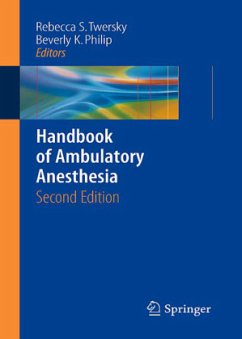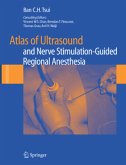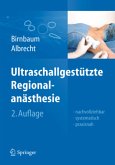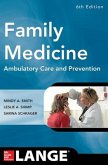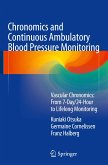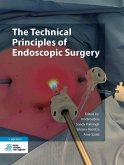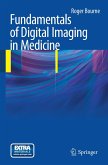This second edition of the Handbook of Ambulatory Anesthesia has been completely updated and expanded to reflect current practice guidelines and trends. It's a practical manual that covers preoperative evaluation, patient and procedure selection, anesthetic techniques, postoperative management, and quality assurance.
Handbook of Ambulatory Anesthesia, second edition, has been completely updated and expanded to reflect current practice guidelines and trends in ambulatory anesthesia. Concise and clinically oriented, it is designed to quickly and effectively steer the practitioner through the challenges and demands of daily practice. The editors and authors are all recognized experts whose outstanding insights will bring readers back to this book again and again. The chapters are consistently formatted with introductory outlines, practical illustrations, informative boxes, clinically oriented tables, and key references. Highlights of the book include:
- preoperative evaluation - anesthesia considerations for minimally invasive and advanced ambulatory surgery procedures - management of common clinical conditions for pediatric and adult patients - preoperative preparation - specific anesthesia techniques: sedation, regional, and general - anesthesia outside the O.R. - office-based anesthesia - recovery and discharge - quality management and accreditation- cost containment - administrative issues - appendix of most commonly referenced figures and tables
Handbook of Ambulatory Anesthesia, second edition, has been completely updated and expanded to reflect current practice guidelines and trends in ambulatory anesthesia. Concise and clinically oriented, it is designed to quickly and effectively steer the practitioner through the challenges and demands of daily practice. The editors and authors are all recognized experts whose outstanding insights will bring readers back to this book again and again. The chapters are consistently formatted with introductory outlines, practical illustrations, informative boxes, clinically oriented tables, and key references. Highlights of the book include:
- preoperative evaluation - anesthesia considerations for minimally invasive and advanced ambulatory surgery procedures - management of common clinical conditions for pediatric and adult patients - preoperative preparation - specific anesthesia techniques: sedation, regional, and general - anesthesia outside the O.R. - office-based anesthesia - recovery and discharge - quality management and accreditation- cost containment - administrative issues - appendix of most commonly referenced figures and tables
From the reviews of the second edition:
"This book provides guidance to practitioners on the clinical and administrative aspects of outpatient anesthesia. Anesthesia providers at all stages of their careers will find this book helpful in expanding their knowledge of the concepts of ambulatory anesthesia and in managing relevant practical matters. Other health professionals involved in ambulatory procedures will also benefit ... . This excellent reference with a unique focus on the practice of outpatient anesthesia is a valuable educational tool for all health professionals participating in outpatient surgery care." (Zdravka Zafirova, Doody's Review Service, August 2008)
"This book will be indispensable to any physician or group setting up a new ASC or office-practice. Chapter 15 (on profitability, efficiency, and cost) should be mandatory reading for any physician of any specialty, even if they never set foot in an ASC. The book's author team has also expanded in number and, therefore, in the breadth of their experience. Most readers will recognize that the group includes academic and private practitioners who populate the podia of national meetings on anesthesia and ambulatory practice, year in and year out." (Douglas G. Merrill, Anesthesia and Analgesia, Vol. 108 (1), January 2009)
"The book conveys valuable information regarding the logistics, regulation, accreditation, administration, and quality control of ambulatory surgical centres. This is the real strength of this book. In conclusion, this handbook would be a worthwhile resource for any anesthesiologist who may be establishing a new ambulatory centre, negotiating financial terms to provide private office based anesthesia, or administering the recovery and discharge process for his/her local hospital." (Andy Meikle, Canadian Journal of Anesthesia, Vol. 55 (11), 2008)
"This book provides guidance to practitioners on the clinical and administrative aspects of outpatient anesthesia. Anesthesia providers at all stages of their careers will find this book helpful in expanding their knowledge of the concepts of ambulatory anesthesia and in managing relevant practical matters. Other health professionals involved in ambulatory procedures will also benefit ... . This excellent reference with a unique focus on the practice of outpatient anesthesia is a valuable educational tool for all health professionals participating in outpatient surgery care." (Zdravka Zafirova, Doody's Review Service, August 2008)
"This book will be indispensable to any physician or group setting up a new ASC or office-practice. Chapter 15 (on profitability, efficiency, and cost) should be mandatory reading for any physician of any specialty, even if they never set foot in an ASC. The book's author team has also expanded in number and, therefore, in the breadth of their experience. Most readers will recognize that the group includes academic and private practitioners who populate the podia of national meetings on anesthesia and ambulatory practice, year in and year out." (Douglas G. Merrill, Anesthesia and Analgesia, Vol. 108 (1), January 2009)
"The book conveys valuable information regarding the logistics, regulation, accreditation, administration, and quality control of ambulatory surgical centres. This is the real strength of this book. In conclusion, this handbook would be a worthwhile resource for any anesthesiologist who may be establishing a new ambulatory centre, negotiating financial terms to provide private office based anesthesia, or administering the recovery and discharge process for his/her local hospital." (Andy Meikle, Canadian Journal of Anesthesia, Vol. 55 (11), 2008)

